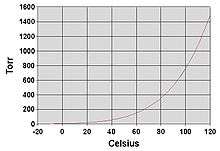Vapor pressure
Vapor pressure (or vapour pressure in British English; see spelling differences) or equilibrium vapor pressure is defined as the pressure exerted by a vapor in thermodynamic equilibrium with its condensed phases (solid or liquid) at a given temperature in a closed system. The equilibrium vapor pressure is an indication of a liquid's evaporation rate. It relates to the tendency of particles to escape from the liquid (or a solid). A substance with a high vapor pressure at normal temperatures is often referred to as volatile. The pressure exhibited by vapor present above a liquid surface is known as vapor pressure. As the temperature of a liquid increases, the kinetic energy of its molecules also increases. As the kinetic energy of the molecules increases, the number of molecules transitioning into a vapor also increases, thereby increasing the vapor pressure.
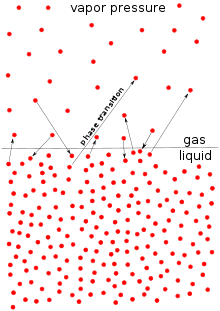
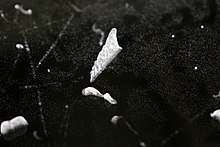
The vapor pressure of any substance increases non-linearly with temperature according to the Clausius–Clapeyron relation. The atmospheric pressure boiling point of a liquid (also known as the normal boiling point) is the temperature at which the vapor pressure equals the ambient atmospheric pressure. With any incremental increase in that temperature, the vapor pressure becomes sufficient to overcome atmospheric pressure and lift the liquid to form vapor bubbles inside the bulk of the substance. Bubble formation deeper in the liquid requires a higher temperature due to the higher fluid pressure, because fluid pressure increases above the atmospheric pressure as the depth increases. More important at shallow depths is the higher temperature required to start bubble formation. The surface tension of the bubble wall leads to an overpressure in the very small, initial bubbles.
The vapor pressure that a single component in a mixture contributes to the total pressure in the system is called partial pressure. For example, air at sea level, and saturated with water vapor at 20 °C, has partial pressures of about 2.3 kPa of water, 78 kPa of nitrogen, 21 kPa of oxygen and 0.9 kPa of argon, totaling 102.2 kPa, making the basis for standard atmospheric pressure.
Measurement and units
Vapor pressure is measured in the standard units of pressure. The International System of Units (SI) recognizes pressure as a derived unit with the dimension of force per area and designates the pascal (Pa) as its standard unit. One pascal is one newton per square meter (N·m−2 or kg·m−1·s−2).
Experimental measurement of vapor pressure is a simple procedure for common pressures between 1 and 200 kPa.[1] Most accurate results are obtained near the boiling point of substances and large errors result for measurements smaller than 1kPa. Procedures often consist of purifying the test substance, isolating it in a container, evacuating any foreign gas, then measuring the equilibrium pressure of the gaseous phase of the substance in the container at different temperatures. Better accuracy is achieved when care is taken to ensure that the entire substance and its vapor are at the prescribed temperature. This is often done, as with the use of an isoteniscope, by submerging the containment area in a liquid bath.
Very low vapor pressures of solids can be measured using the Knudsen effusion cell method.
In a medical context, vapor pressure is sometimes expressed in other units, specifically millimeters of mercury (mmHg). This is important for volatile anesthetics, most of which are liquids at body temperature, but with a relatively high vapor pressure.
Estimating vapor pressures with Antoine equation
The Antoine equation[2][3] is a pragmatic mathematical expression of the relation between the vapor pressure and the temperature of pure liquid or solid substances. It is obtained by curve-fitting and is adapted to the fact that vapor pressure is usually increasing and concave as a function of temperature. The basic form of the equation is:
and it can be transformed into this temperature-explicit form:
where:
- is the absolute vapor pressure of a substance
- is the temperature of the substance
- , and are substance-specific coefficients (i.e., constants or parameters)
- is typically either or [3]
A simpler form of the equation with only two coefficients is sometimes used:
which can be transformed to:
Sublimations and vaporizations of the same substance have separate sets of Antoine coefficients, as do components in mixtures.[2] Each parameter set for a specific compound is only applicable over a specified temperature range. Generally, temperature ranges are chosen to maintain the equation's accuracy of a few up to 8–10 percent. For many volatile substances, several different sets of parameters are available and used for different temperature ranges. The Antoine equation has poor accuracy with any single parameter set when used from a compound's melting point to its critical temperature. Accuracy is also usually poor when vapor pressure is under 10 Torr because of the limitations of the apparatus used to establish the Antoine parameter values.
The Wagner equation[4] gives "one of the best"[5] fits to experimental data but is quite complex. It expresses reduced vapor pressure as a function of reduced temperature.
Relation to boiling point of liquids
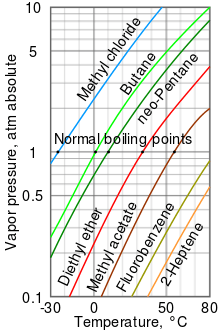
As a general trend, vapor pressures of liquids at ambient temperatures increase with decreasing boiling points. This is illustrated in the vapor pressure chart (see right) that shows graphs of the vapor pressures versus temperatures for a variety of liquids.[6] At the normal boiling point of a liquid, the vapor pressure is equal to the standard atmospheric pressure defined as 1 atmosphere,[7] 760 Torr, 101.325 kPa, or 14.69595 psi.
For example, at any given temperature, methyl chloride has the highest vapor pressure of any of the liquids in the chart. It also has the lowest normal boiling point (−24.2 °C), which is where the vapor pressure curve of methyl chloride (the blue line) intersects the horizontal pressure line of one atmosphere (atm) of absolute vapor pressure.
Although the relation between vapor pressure and temperature is non-linear, the chart uses a logarithmic vertical axis to produce slightly curved lines, so one chart can graph many liquids. A nearly straight line is obtained when the logarithm of the vapor pressure is plotted against 1/(T + 230)[8] where T is the temperature in degrees Celsius. The vapor pressure of a liquid at its boiling point equals the pressure of its surrounding environment.
Liquid mixtures
Raoult's law gives an approximation to the vapor pressure of mixtures of liquids. It states that the activity (pressure or fugacity) of a single-phase mixture is equal to the mole-fraction-weighted sum of the components' vapor pressures:
where is the mixture's vapor pressure, is the mole fraction of component in the liquid phase and is the mole fraction of component in the vapor phase respectively. is the vapor pressure of component . Raoult's law is applicable only to non-electrolytes (uncharged species); it is most appropriate for non-polar molecules with only weak intermolecular attractions (such as London forces).
Systems that have vapor pressures higher than indicated by the above formula are said to have positive deviations. Such a deviation suggests weaker intermolecular attraction than in the pure components, so that the molecules can be thought of as being "held in" the liquid phase less strongly than in the pure liquid. An example is the azeotrope of approximately 95% ethanol and water. Because the azeotrope's vapor pressure is higher than predicted by Raoult's law, it boils at a temperature below that of either pure component.
There are also systems with negative deviations that have vapor pressures that are lower than expected. Such a deviation is evidence for stronger intermolecular attraction between the constituents of the mixture than exists in the pure components. Thus, the molecules are "held in" the liquid more strongly when a second molecule is present. An example is a mixture of trichloromethane (chloroform) and 2-propanone (acetone), which boils above the boiling point of either pure component.
The negative and positive deviations can be used to determine thermodynamic activity coefficients of the components of mixtures.
Solids
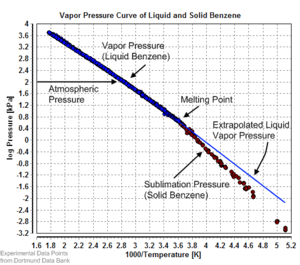
Equilibrium vapor pressure can be defined as the pressure reached when a condensed phase is in equilibrium with its own vapor. In the case of an equilibrium solid, such as a crystal, this can be defined as the pressure when the rate of sublimation of a solid matches the rate of deposition of its vapor phase. For most solids this pressure is very low, but some notable exceptions are naphthalene, dry ice (the vapor pressure of dry ice is 5.73 MPa (831 psi, 56.5 atm) at 20 °C, which causes most sealed containers to rupture), and ice. All solid materials have a vapor pressure. However, due to their often extremely low values, measurement can be rather difficult. Typical techniques include the use of thermogravimetry and gas transpiration.
There are a number of methods for calculating the sublimation pressure (i.e., the vapor pressure) of a solid. One method is to estimate the sublimation pressure from extrapolated liquid vapor pressures (of the supercooled liquid), if the heat of fusion is known, by using this particular form of the Clausius–Clapeyron relation:[9]
where:
- is the sublimation pressure of the solid component at the temperature .
- is the extrapolated vapor pressure of the liquid component at the temperature .
- is the heat of fusion.
- is the gas constant.
- is the sublimation temperature.
- is the melting point temperature.
This method assumes that the heat of fusion is temperature-independent, ignores additional transition temperatures between different solid phases, and it gives a fair estimation for temperatures not too far from the melting point. It also shows that the sublimation pressure is lower than the extrapolated liquid vapor pressure (ΔfusH > 0) and the difference grows with increased distance from the melting point.
Boiling point of water
Like all liquids, water boils when its vapor pressure reaches its surrounding pressure. In nature, the atmospheric pressure is lower at higher elevations and water boils at a lower temperature. The boiling temperature of water for atmospheric pressures can be approximated by the Antoine equation:
or transformed into this temperature-explicit form:
where the temperature is the boiling point in degrees Celsius and the pressure is in Torr.
Dühring's rule
Dühring's rule states that a linear relationship exists between the temperatures at which two solutions exert the same vapor pressure.
Examples
The following table is a list of a variety of substances ordered by increasing vapor pressure (in absolute units).
| Substance | Vapor pressure | Temperature (°C) | ||
|---|---|---|---|---|
| (Pa) | (bar) | (mmHg) | ||
| Tungsten | 100 Pa | 0.001 | 0.75 | 3203 |
| Ethylene glycol | 500 Pa | 0.005 | 3.75 | 20 |
| Xenon difluoride | 600 Pa | 0.006 | 4.50 | 25 |
| Water (H2O) | 2.3 kPa | 0.023 | 17.5 | 20 |
| Propanol | 2.4 kPa | 0.024 | 18.0 | 20 |
| Methyl isobutyl ketone | 2.66 kPa | 0.0266 | 19.95 | 25 |
| Ethanol | 5.83 kPa | 0.0583 | 43.7 | 20 |
| Freon 113 | 37.9 kPa | 0.379 | 284 | 20 |
| Acetaldehyde | 98.7 kPa | 0.987 | 740 | 20 |
| Butane | 220 kPa | 2.2 | 1650 | 20 |
| Formaldehyde | 435.7 kPa | 4.357 | 3268 | 20 |
| Propane[10] | 997.8 kPa | 9.978 | 7584 | 26.85 |
| Carbonyl sulfide | 1.255 MPa | 12.55 | 9412 | 25 |
| Nitrous oxide[11] | 5.660 MPa | 56.60 | 42453 | 25 |
| Carbon dioxide | 5.7 MPa | 57 | 42753 | 20 |
Estimating vapor pressure from molecular structure
Several empirical methods exist to estimate the vapor pressure from molecular structure for organic molecules. Some examples are SIMPOL.1 method,[12] the method of Moller et al.,[9] and EVAPORATION (Estimation of VApour Pressure of ORganics, Accounting for Temperature, Intramolecular, and Non-additivity effects).[13][14]
Meaning in meteorology
In meteorology, the term vapor pressure is used to mean the partial pressure of water vapor in the atmosphere, even if it is not in equilibrium,[15] and the equilibrium vapor pressure is specified otherwise. Meteorologists also use the term saturation vapor pressure to refer to the equilibrium vapor pressure of water or brine above a flat surface, to distinguish it from equilibrium vapor pressure, which takes into account the shape and size of water droplets and particulates in the atmosphere.[16]
See also
References
- Růžička, K.; Fulem, M. & Růžička, V. "Vapor Pressure of Organic Compounds. Measurement and Correlation" (PDF). Archived from the original (PDF) on 2010-12-26. Retrieved 2009-10-18.
- What is the Antoine Equation? (Chemistry Department, Frostburg State University, Maryland)
- Sinnot, R.K. (2005). Chemical Engineering Design] (4th ed.). Butterworth-Heinemann. p. 331. ISBN 978-0-7506-6538-4.
- Wagner, W. (1973), "New vapour pressure measurements for argon and nitrogen and a new method for establishing rational vapour pressure equations", Cryogenics, 13 (8): 470–482, Bibcode:1973Cryo...13..470W, doi:10.1016/0011-2275(73)90003-9
- Perry's Chemical Engineers' Handbook, 7th Ed. pp. 4–15
- Perry, R.H.; Green, D.W., eds. (1997). Perry's Chemical Engineers' Handbook (7th ed.). McGraw-Hill. ISBN 978-0-07-049841-9.
- Petrucci, Ralph H.; Harwood, William S.; Herring, F.Geoffrey (2002). General Chemistry (8th ed.). Prentice Hall. p. 484. ISBN 978-0-13-014329-7.
- Dreisbach, R. R. & Spencer, R. S. (1949). "Infinite Points of Cox Chart Families and dt/dP Values at any Pressure". Industrial and Engineering Chemistry. 41 (1). p. 176. doi:10.1021/ie50469a040.
- Moller B.; Rarey J.; Ramjugernath D. (2008). "Estimation of the vapour pressure of non-electrolyte organic compounds via group contributions and group interactions". Journal of Molecular Liquids. 143: 52–63. doi:10.1016/j.molliq.2008.04.020.
- "Thermophysical Properties Of Fluids II – Methane, Ethane, Propane, Isobutane, And Normal Butane" (page 110 of PDF, page 686 of original document), BA Younglove and JF Ely.
- "Thermophysical Properties Of Nitrous Oxide" (page 14 of PDF, page 10 of original document), ESDU.
- Pankow, J. F.; et al. (2008). "SIMPOL.1: a simple group contribution method for predicting vapor pressures and enthalpies of vaporization of multifunctional organic compounds". Atmos. Chem. Phys. 8 (10): 2773–2796. doi:10.5194/acp-8-2773-2008.
- "Vapour pressure of Pure Liquid Organic Compounds: Estimation by EVAPORATION". Tropospheric Chemistry Modelling at BIRA-IASB. 11 June 2014. Retrieved 2018-11-26.
- Compernolle, S.; et al. (2011). "EVAPORATION: a new vapour pressure estimation method for organic molecules including non-additivity and intramolecular interactions". Atmos. Chem. Phys. 11 (18): 9431–9450. Bibcode:2011ACP....11.9431C. doi:10.5194/acp-11-9431-2011.
- Glossary Archived 2011-04-15 at the Wayback Machine (Developed by the American Meteorological Society)
- A Brief Tutorial. jhuapl.edu (An article about the definition of equilibrium vapor pressure)
